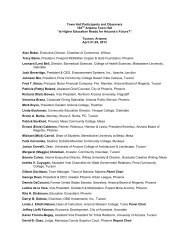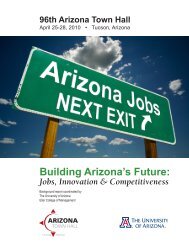Background Report - Arizona Town Hall
Background Report - Arizona Town Hall
Background Report - Arizona Town Hall
Create successful ePaper yourself
Turn your PDF publications into a flip-book with our unique Google optimized e-Paper software.
Matthew Moore is a fourth generation farmer whose land and life is quickly being overcome<br />
by suburban sprawl. He creates large site-specific earthworks on and around his family’s<br />
land, which highlight the grounds on which the urban and rural collide and compete. Moore<br />
also works with video and installation art, addressing issues of ecological, cultural, and<br />
economical sustainability revealed through his artistic narrative regarding the potential loss<br />
of the romanticized American farm. Moore’s work is a part of a traveling show about the<br />
contemporary American suburb for the Walker Art Center in Minneapolis, which is being<br />
curated with the Heinz Architectural Center at the Carnegie Museum of Art in Pittsburgh.<br />
Artist Statement: I am the last of four generations to farm my family’s land. Within five<br />
years, my home (this land) will transform into suburbia. As a farmer and an artist, I display<br />
the realities of this transition in order to rationalize and document my displacement from the<br />
land on which I was raised. The trials and tribulations of American agriculture, its roles in<br />
contemporary globalization, and its questionable ecological practices create a foundation for<br />
my explorations. By displaying the past and future of the farm, I have used our land to<br />
explore similarities between commercial agriculture and suburbia, which reveal their social,<br />
cultural, and economic impacts locally, nationally, and internationally. Documenting the<br />
reality of land and appetite from agriculture to suburbia, the decisions of our society reveal<br />
consumer models that make us disobedient to our relationship with land and time. By<br />
exhibiting this theater of evolution and loss, I have entered a historical dialogue of<br />
displacement that reveals my part (in agriculture) in the transformation of my family’s land<br />
and identity. Through my artwork, I look at these dilemmas that reveal the impact of the<br />
American dream on our society and the land as we transition towards a post agrarian nation.<br />
Alberto Rios is a Regents’ Professor at <strong>Arizona</strong> State University, and Katherine C. Turner<br />
Endowed Chair in English. He is the author of ten books and chapbooks of poetry,<br />
three collections of short stories, and a memoir. His books of poems include, most recently,<br />
The Dangerous Shirt, along with The Theater of Night, winner of the 2007 PEN/Beyond<br />
Margins Award, The Smallest Muscle in the Human Body, finalist for the National Book<br />
Award, Teodoro Luna’s Two Kisses, The Lime Orchard Woman, The Warrington Poems, Five<br />
Indiscretions, and Whispering to Fool the Wind, which won the Walt Whitman Award. His<br />
three collections of short stories are, most recently, The Curtain of Trees, along with Pig<br />
Cookies and The Iguana Killer, which won the first Western States Book Award for Fiction,<br />
judged by Robert Penn Warren. His memoir about growing up on the Mexico-<strong>Arizona</strong><br />
border, called Capirotada, won the Latino Literary <strong>Hall</strong> of Fame Award and was designated<br />
the OneBook<strong>Arizona</strong> choice for 2009. Rios is the recipient of the Western Literature<br />
Association Distinguished Achievement Award, the <strong>Arizona</strong> Governor’s Arts Award,<br />
fellowships from the Guggenheim Foundation and the National Endowment for the Arts, the<br />
Walt Whitman Award, the Western States Book Award for Fiction, six Pushcart Prizes in<br />
both poetry and fiction, and inclusion in The Norton Anthology of Modern Poetry, as well as<br />
over 250 other national and international literary anthologies. His work is regularly taught<br />
and translated, and has been adapted to dance and both classical and popular music.<br />
Byron Wolfe is the David W. and Helen E.F. Lantis University Professor of Communication<br />
Design at California State University, Chico. Through photography and digital imagery,<br />
he reflects his deep and abiding interest in ideas about place, history, time, perception,<br />
representation, and personal experience. His work is the permanent collection of the San<br />
Francisco Museum of Modern Art; The Museum of Fine Arts, Houston; The Center for<br />
Appendix | 245




